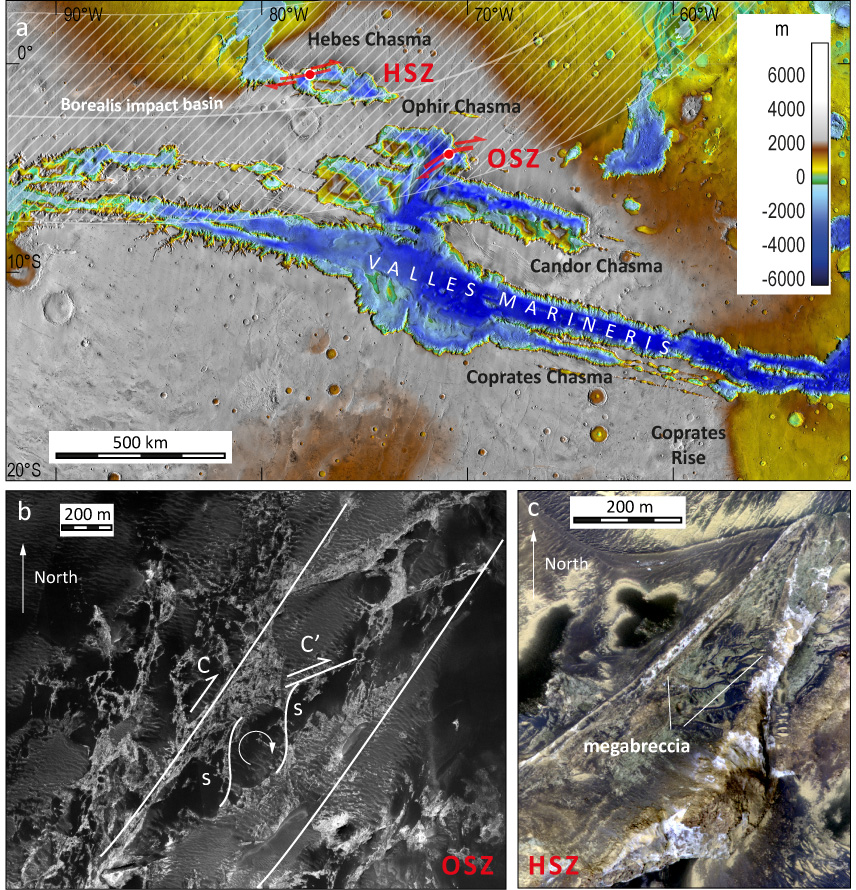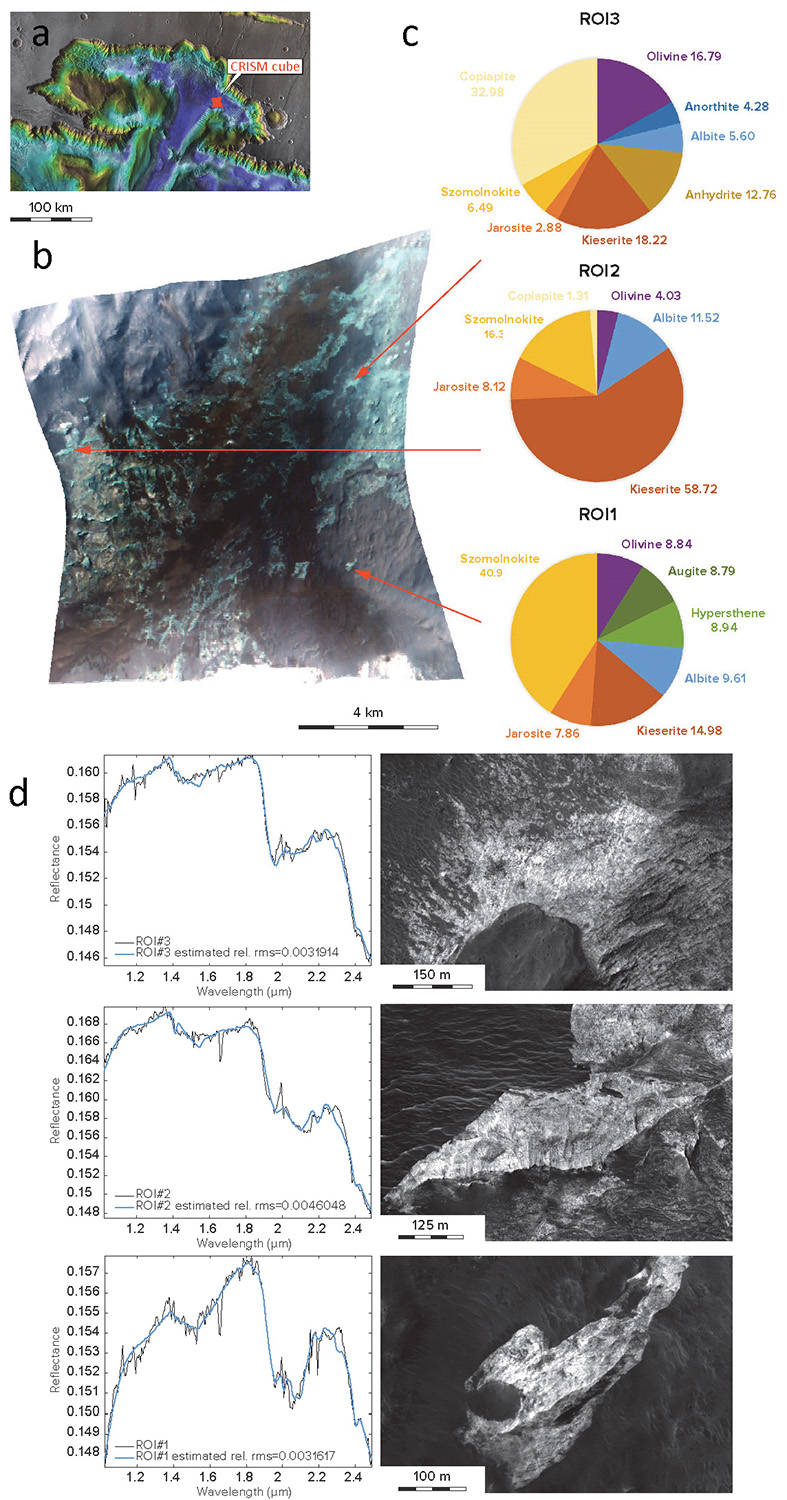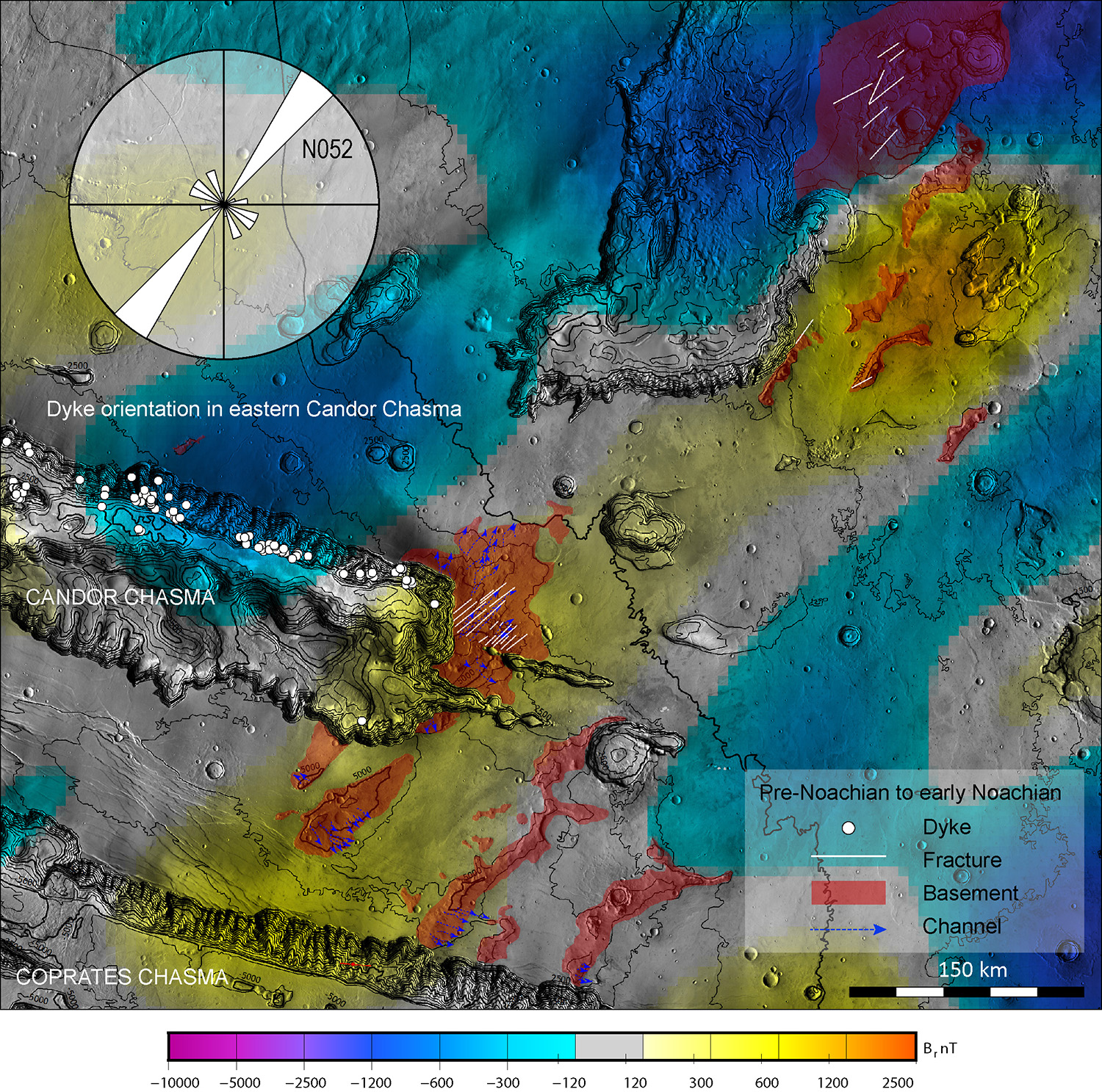Tectonic and hydrothermal activity at the edge of the Borealis impact basin in Valles Marineris
- 1Space Research Centre PAS, Warsaw, Poland (dmege@cbk.waw.pl)
- 2Université Paris-Saclay, CNRS, GEOPS, 91405, Orsay, France
- 3Institut Universitaire de France (IUF)
- 4Orion Geomechanics LLC, Cypress, Texas, USA
- 5Institut de Planétologie et d’Astrophysique de Grenoble, UMR CNRS 5274, France
- 6CNRS, Nantes Univ., Angers Univ., Le Mans Univ., France
Introduction: The edge of the pre-Noachian Borealis impact basin, thought to be the cause of the planetary dichotomy boundary [1-2], crosses the northern Valles Marineris troughs [1-3]. Intense deformation is exposed in the deepest parts of the Ophir and Hebes Chasmata, the northernmost troughs. Structural geology and mineralogical analyses motivate the tentative identification of brittle and brittle-ductile shear zones and hydrothermal activity in the Valles Marineris basement. Implications for the Borealis basin and the proto-Valles Marineris crust are examined.
Structural analysis: Crustal right-lateral shear zones are identified in the pre-Noachian basement of Ophir and Hebes Chasmata (Figure 1). In Ophir Chasma, S-C-C' structures, indicate deformation in the brittle-ductile domain. In Hebes Chasma, megabreccia indicates brittle deformation. From scaling relationships [4-5], the shear zones are inferred to be at least hundreds of kilometers long. They do not extend to the surface nor even up into the interior layered deposits (ILD), and are therefore interpreted to affect the Valles Marineris basement only, which at this depth, is interpreted to be of pre-Noachian age.
Mineralogy: A new method of non-linear spectral unmixing derived from the LinMin algorithm [6] is implemented and applied to three pre-Noachian basement exposures in a CRISM cube in Ophir Chasma. After gas absorption removal, two groups of minerals are robustly detected (Figure 2): primary minerals of mafic rocks (olivine, hypersthene, augite, anorthite, albite), and sulfates, most of them likely of hydrothermal origin (copiapite, jarosite, szomolnokite). Anhydrite (ROI3) is not diagnostic of any particular environment. Kieserite is interpreted as transported by wind from the neighboring ILDs. S-C-C' structures constrain the granulometry of the sheared rock which, under the assumption that all the primary minerals are detected, would be olivine-gabbronorite (ROI1) or troctolite (ROI2-3). Combined structural and mineralogical analyses point to hydrothermal alteration of a mafic intrusive basement, or contamination of this basement by hydrothermal activity in the ILDs.
Relationships with the Borealis basin: The general trend of the shear zones follows the edge of the Borealis as inferred from gravity and topography [4], also of pre-Noachian age, suggesting that they may have initiated as basin ring faults and were reactivated as crustal shears. North of Valles Marineris, the radial component of the remanent magnetic field at the surface [7] shows elongated anomalies that follow the trend of the shear zones and more generally, the expected curved edge of the Borealis basin. The existence of a magnetic field (or dynamo) was coeval with formation of the planetary dichotomy boundary [8]. Two anomalies also correspond to Noachian or pre-Noachian crustal ridges in Ophir Planum, of igneous [9] or tectonic [10] origin. Mapping reveals that the ridges are fractured parallel to the magnetic anomalies, and that their topography guided a hydrologic system (Figure 3). Moreover, these fractures are parallel to a dyke swarm exposed in eastern Candor Chasma [11]. Therefore, the ridges have a volcanotectonic origin within an active hydrologic context.

Figure 1. Ophir shear zone (OSZ) and Hebes shear zone (HSZ): (a) location map showing trace of the Borealis impact basin with ±5° uncertainty (dashed area) [5]; (b) zoom on S-C-C' structures in the OSZ, and illustration of shear orientations; (c) zoom on fault megabreccia in the HSZ. HiRISE images ESP_017754_1755 and ESP_040211_1790.

Figure 2. Results of nonlinear spectral unmixing applied to basement exposures in Ophir Chasma: (a) CRISM cube location (frt00018b55_07_if165l_trr3); (b) the cube (bands R: 233, G: 78, B: 13); (c) mineral relative abundances, after aerosol contribution removal; (d) best fit plots and HiRISE images of the basement exposures: ESP_051999_1755, ESP_039525_1755, ESP_039525_1755.

Figure 3. Features related to hydrothermal activity possibly resulting from the Borealis impact and suggested to explain magnetic banding north of Coprates Chasma. Dykes are located thanks to HiRISE images. The rose diagram was established from 26 representative dykes observed on the eastern Candor Chasma wall; the indicated strike refers to the mean resultant dyke orientation. Magnetic anomalies are from [7]. Topographic contours (spacing 500 m) are from HRSC (ESA/DLR/Freie Univ. Berlin).
Circumferential magnetic anomalies are observed at some terrestrial impact craters (e.g.[12]) as well as the Chicxulub impact basin [13] and are due to crystallization of magnetic minerals in an impact-related hydrothermal system [14]. We suggest, therefore, that the magnetic anomalies measured above the Valles Marineris plateau similarly result from hydrothermal activity in response to the Borealis impact, and follow basin ring structures. This hydrothermal activity might be the surface counterpart of deep hydrothermal activity in the basement detected using spectral unmixing [15].
Conclusions: Analysis of northeastern Valles Marineris supports the interpretation of a pre-Noachian Borealis impact basin that would have underlain the later northern troughs of Valles Marineris in the presence of an active dynamo. Large shear zones in the Valles Marineris basement would be reactivated ring faults. Borealis basin formation may have triggered a huge hydrothermal system, identified along these structures and also producing magnetic minerals that generated the observed magnetic anomalies. Primary deposits of base and rare metals likely formed as well. Other evidence of hydrothermal activity at the edge of the Borealis basin would confirm these interpretations.
References: [1] Andrews-Hanna J. et al. (2008) Nature, 453, 1212–1215. [2] Marinova M. M. et al. (2008) Nature, 453, 1216–1219. [3] Andrews-Hanna J. (2012) J. Geophys. Res., 117, E03006. [4] Schultz R. A. and Fossen H. (2002) J. Struct. Geol. 24, 1389–1411. [5] Fossen H. (2010) Structural Geology, Cambridge Univ. Press. [6] Schmidt F. et al. (2014) Icarus, 237, 61–74. [7] Langlais B. et al. (2019) J. Geophys Res., 109, E02008. [8] Mittelholz et al. (2020) Sci. Adv., eaba0513. [9] Tanaka K. L. et al. (2014) USGS Sci. Inv. Map 3292. [10] Viviano-Beck et al. (2017) Icarus, 284, 43–58. [11] Mège D. and Gurgurewicz J. (2017) 48th LPSC, Abstract #1087. [12] Hawke P. J. et al. (2006) Explor. Geophys., 37, 191–196. [13] Abramov O. and Kring D. A. Meteor. Planet. Sci., 42, 93–112. [14] Osinski G. R. et al. (2011) Meteor. Planet. Sci., 36, 731–745. [15] Gurgurewicz J. et al., submitted to Commun. Earth Environ.
How to cite: Mège, D., Gurgurewicz, J., Schmidt, F., Schultz, R. A., Douté, S., and Langlais, B.: Tectonic and hydrothermal activity at the edge of the Borealis impact basin in Valles Marineris, Europlanet Science Congress 2022, Granada, Spain, 18–23 Sep 2022, EPSC2022-116, https://doi.org/10.5194/epsc2022-116, 2022.

